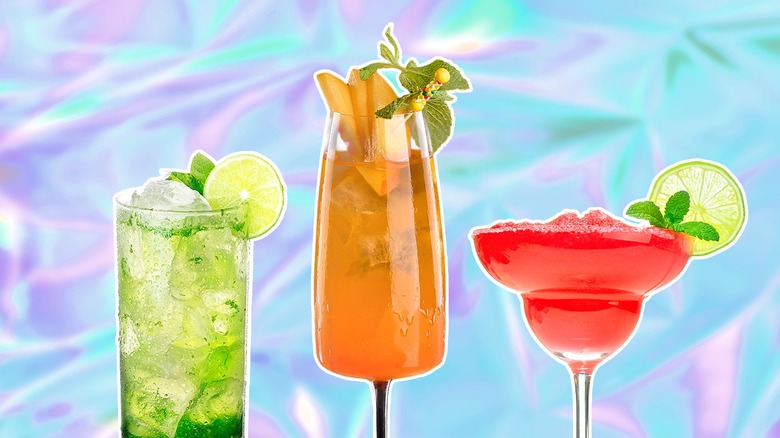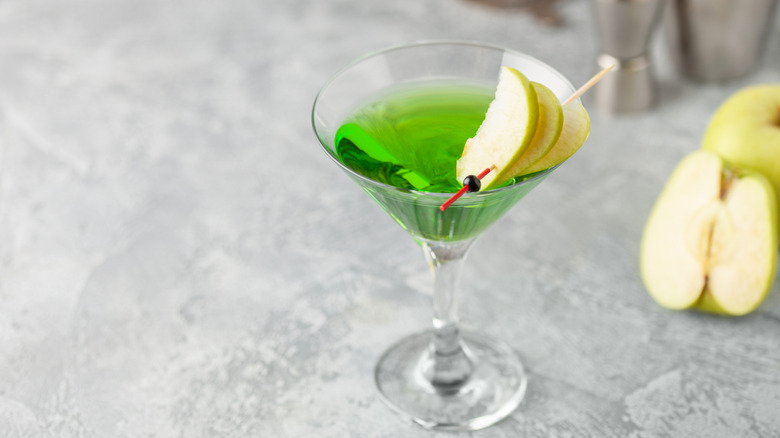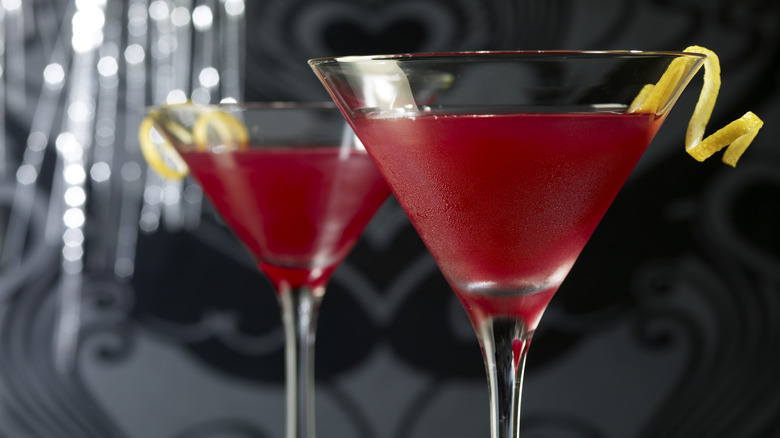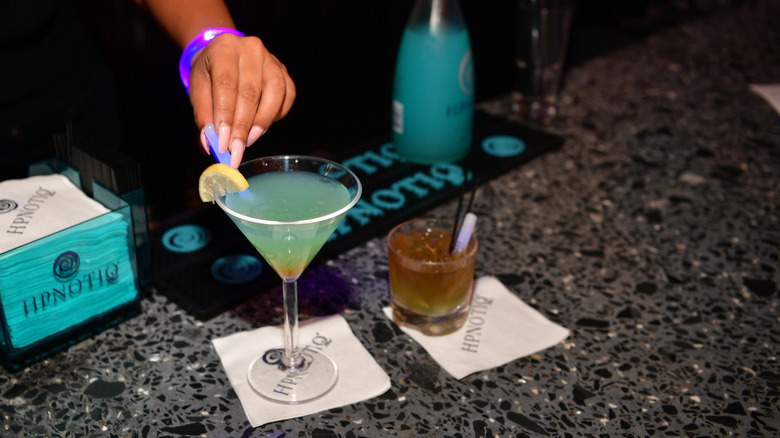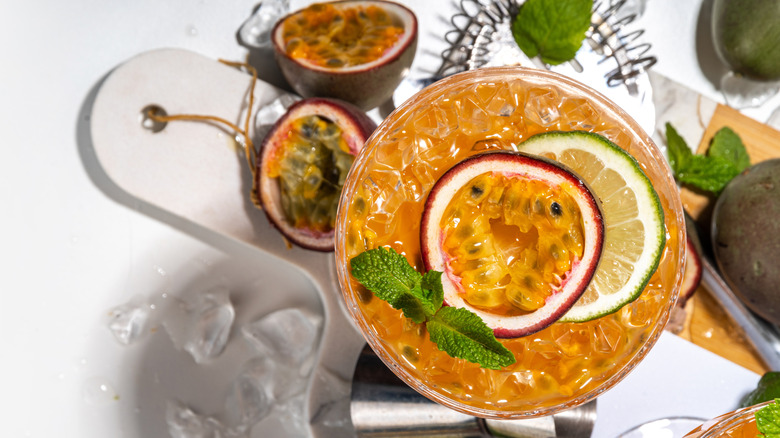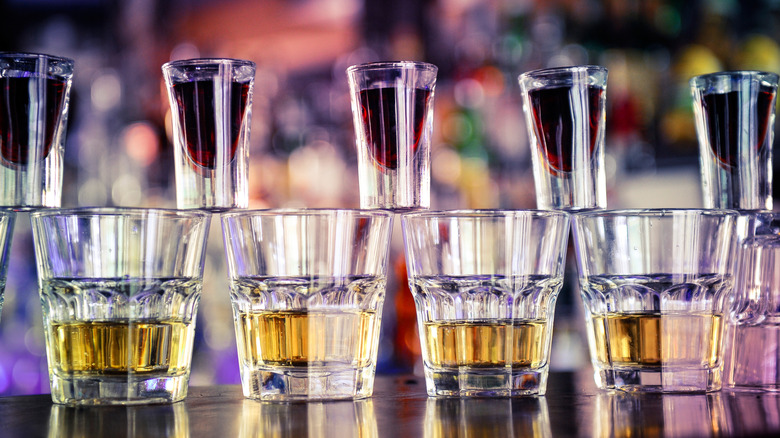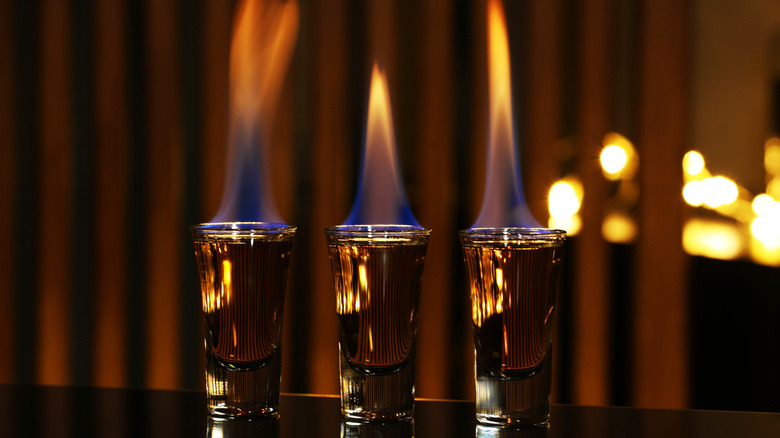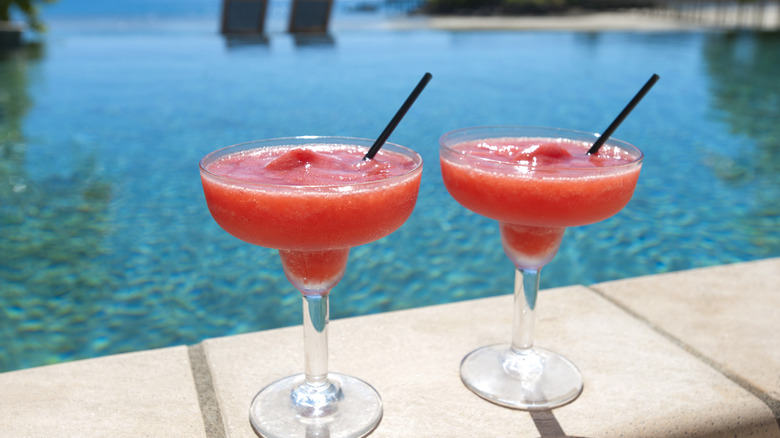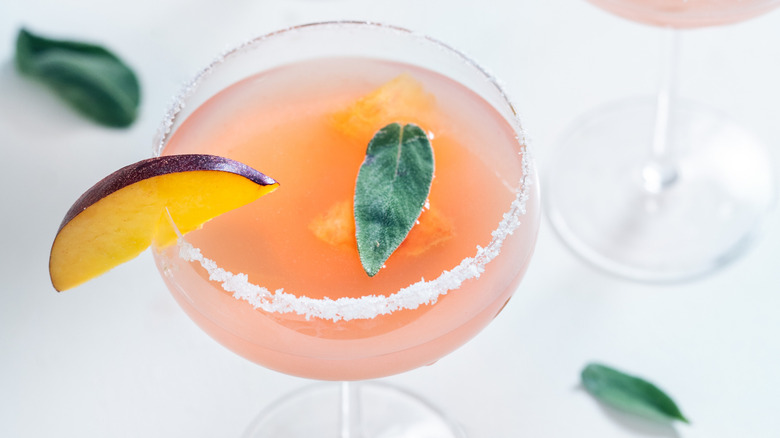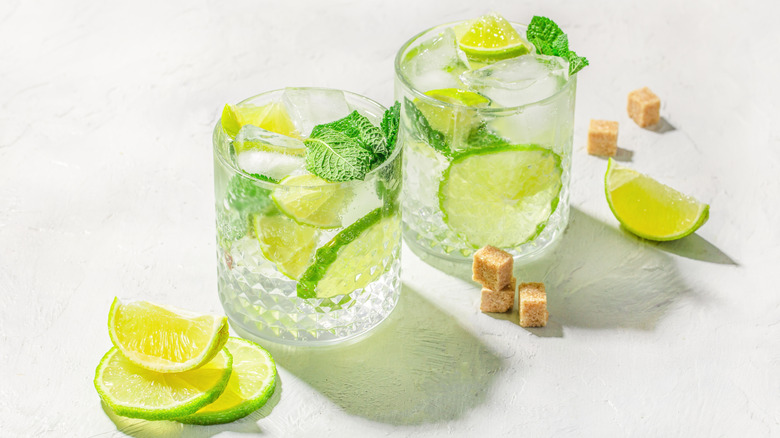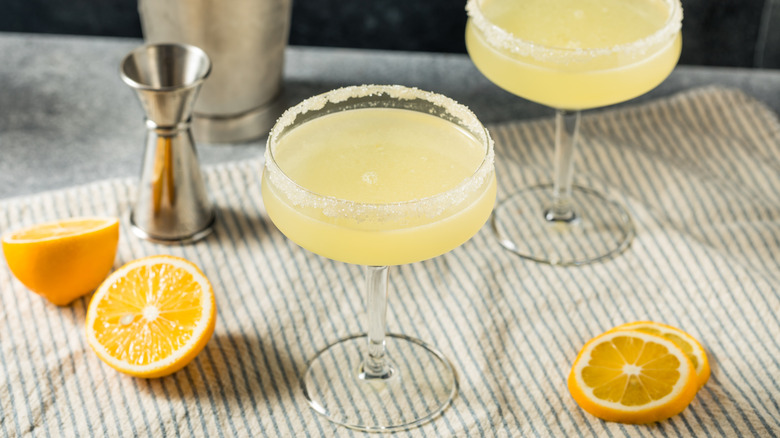The 10 Cocktails That Defined The 2000s
Before the cocktail renaissance taught us about amaro, clarified ice, and milk punches dating back to the 1700s, there was a glorious, unhinged chapter in drinking history: the 2000s. This was an era when subtlety was non-existent, balance was boring, and cocktails were loud — in flavor, color, and attitude. We're talking electric blue martinis, glow-in-the-dark shooters, and anything that looked like a chemical spill in a coupe.
Let's set the scene. It's the mid-2000s, Paris Hilton is feuding with LiLo, everyone just joined Facebook, and peeps are drinking Peach Bellinis out of fishbowls at Moxies. You see, this was the first true generation of camera phones and early social media. People weren't drinking for taste, they were drinking for the photo (likely taken on a Motorola Razr). The drinks they were ordering had to match the moment: a glittery halter top, low-rise Apple Bottom jeans, boots with the furrrrr, and something radioactive in a martini glass.
From the nuclear green Appletini to the chaos of a Flaming Dr. Pepper shot, this was the era of liquid candy, zero shame, and "No Ragrets" energy. And honestly? We kinda miss it. Now, with Y2K nostalgia in full swing, modern bartenders are remixing these sugary icons with better booze and actual technique. Here's a rundown of the cocktails that defined a generation of Juicy tracksuit-wearing Millennials.
Appletini
Neon green and unapologetically sweet, the Appletini is not commonly found on bar menus anymore (and sometimes considered embarrassing to order), but believe it or not, some bartenders are actually rooting for its comeback. Originally invented at Lola's, a well-known bar in West Hollywood, the Appletini first gained popularity in the late '90s. By the 2000s, it was a bar staple. Bright, bold, and often extremely sweet, it fit right in with the Y2K obsession of yummy, showy, technicolor drinks.
Pop culture also couldn't resist. It became the drink of choice for Zach Braff's character on Scrubs, got ordered by Ted Mosby on How I Met Your Mother, and even made a random cameo in The Social Network, where it was shown as Mark Zuckerberg's beverage of choice (even though the real Zuckerberg had never heard of this drink before). Made with vodka, Sour Apple Pucker, a hit of lemon juice, and a splash of Cointreau, the drink was basically liquid candy for young adults presented in a martini glass to make it "classy."
Cosmopolitan
Pink, punchy, and forever associated with Carrie Bradshaw, the Cosmopolitan is the cocktail that went from '90s darling to full-blown 2000s icon. Long before the mixology revival took hold, the Cosmo was the drink that made you feel instantly glamorous. It wasn't just a cocktail — it was a lifestyle accessory. If you were holding one, you weren't just out for a drink. You were out on the town.
The Cosmopolitan became a household name thanks to Sex and the City, but its roots apparently go back to 1988, when bartender Toby Cecchini invented the modern recipe in New York. It exploded in the early 2000s, quickly becoming the go-to order for rooftop lounges and girls' nights everywhere. Its millennial pink hue, paired with the elegance of a stemmed glass, made it the unofficial drink of female empowerment. Today, the Cosmo is considered a bar classic, but you can also enjoy it at home with Aldi's version that's shaking up happy hour on a budget.
To make a classic Cosmo, shake together 1.5 ounces of vodka, 1 ounce of cranberry juice, 1 ounce of triple sec (like Cointreau), and 1 ounce of freshly squeezed lime juice, then strain it into a chilled martini glass. Garnish with an orange twist. For a modern spin, swap out the overly sweet cranberry juice for hibiscus tea or use cranberry sauce. Other tips include chilling your martini glass, using dry Curaçao instead of triple sec, and reaching for a citrus vodka or even gin for extra complexity. The result is cleaner, crisper, and fewer calories.
Hpnotiq Breeze
If you were drinking this in the early 2000s, you were either in VIP or pretending to be. The Hpnotiq Breeze is a tropical, easy-drinking cocktail made with Hpnotiq, pineapple juice, and coconut rum. It looks like a blue Gatorade smoothie and tastes like the beach. Traditionally served over ice, blended in a slush, or mixed in a highball glass, this cocktail was a staple at flashy nightclubs and even flashier bachelorette parties.
Hpnotiq itself was created in 2001 by Raphael Yakoby, a college dropout from Long Island who was inspired by a blue perfume bottle at Bloomingdale's. It's made from fruit juice, French vodka, and cognac. It was promoted extremely well throughout hip-hop circles and became a staple in clubs, music videos, and bottle-service menus. At its peak, it was even name-dropped by Missy Elliot in "Pass That Dutch" and by David Banner featuring Twista and Busta Rhymes in the 2003 song "Like a Pimp." It was such a hot commodity that Yakoby sold the brand to Heaven Hill Distilleries for a reported $50 million.
While Hpnotiq fell out of fashion with the rise of craft cocktails, it is making a quiet comeback as of this publication, especially among younger drinkers who never experienced its full glory. When remixed with fresher ingredients and a little restraint, the Hpnotiq Breeze still slaps. It's not subtle. It's not serious. But sometimes, you just want your drink to match your vibe, and nothing says "main character energy" quite like a turquoise cocktail in the VIP section.
Porn Star Martini
The Porn Star Martini (not to be confused with the Porn Star Shooter) is a cocktail that struts into a bar. And with a name like that, how could it not? Made with passion fruit, it is sweet, sour, and bubbly. Fun fact: Not only was it popular in the 2000s, but it was also one of the most Googled cocktails of 2024.
Created in 2002 by legendary London bartender Douglas Ankrah at the Townhouse Bar in Knightsbridge, the drink was originally called the "Maverick Martini," after a South African gentlemen's club he'd visited. But that didn't stick. Inspired by the bold, brash, vanilla-scented body lotions worn by the dancers, he renamed it the Porn Star Martini because, as he told The Buyer, "I thought it was something that a pornstar would drink." And just like that, a cocktail star was born.
The classic Porn Star Martini recipe combines vanilla vodka, passion fruit puree, lime juice, and vanilla syrup, shaken and strained into a coupe. It's served with a halved passion fruit floating on top and a chilled shot of prosecco on the side. You can sip the bubbles or pour it directly into the drink. The drink became a UK nightclub staple throughout the 2000s and has found renewed fame on TikTok and in cocktail bars leaning into cheeky nostalgia. As of this publication, bartenders often upgrade the drink with real vanilla bean, fresh passion fruit, or even swap the prosecco for Champagne (if you're feeling fancy).
Jager Bomb
If you came of age in the 2000s, the Jager Bomb was a rite of passage. This simple two-part concoction is like a frat party in a glass: loud, chaotic, and unforgettable for all the wrong reasons. It's not refined. It's not subtle. In fact, as a spirits writer, calling this a "cocktail" feels like a crime to mixology. But if you partied during Y2K, odds are you had at least one night that started with this infamous drop shot. And like many beloved 2000s cocktails, it looks (and probably is) radioactive.
By the mid-2000s, Jager Bombs were everywhere. From college bars to bottle-service clubs, it was the global symbol of party culture. In fact, the song "Shots" by LMFAO is literally about shooting Jager Bombs. They were even featured on Jersey Shore, where it fueled Ronnie and Pauly D's gym-tan-laundry-styled nightlife.
The drink is simple: Pour half a can of Red Bull into a pint glass, then drop in a shot of Jagermeister, a German herbal liqueur made from 56 botanicals, and CHUG. Its flavor is a mashup of sweet, bitter, and herbal cough syrup with a spike of caffeine.
Flaming Dr. Pepper
Despite the name, the Flaming Dr. Pepper does not actually contain any of the soda. Technically, it's also not a cocktail (it's a shot), but it is one of the most chaotic drinks to ever come out of a college bar. Its magic lies in the fact that it mimics the 23-flavor complexity of Dr. Pepper without actually having a single drop of it. In the 2000s, the Chicago Tribune associated this drink with undergrad Greek life. It's part shot, part pyrotechnic, and 100% a bad idea in frat houses.
Its theatrical nature made it an instant hit at college parties, where setting things on fire was deeply appealing. But the flames aren't just for show. When alcohol is ignited, the heat triggers a caramelization process, breaking down sugars and volatile compounds. This not only intensifies sweetness but also smooths out the harsh edges and adds subtle smoky notes, making it easier to drink. It goes down so easily that a group of college students once consumed 143 Flaming Dr. Pepper shots in one sitting.
The standard recipe includes a shot glass filled with amaretto, topped with a float of high-proof rum (usually Bacardi 151). The shot is then carefully lit on fire and dropped into a half pint of beer. Once the flaming shot hits the beer, the fire extinguishes, and then you down it. It's very important to do these steps in order, as drinking a still-flaming shot could lead to singed eyebrows ... or worse. Be sure to bone up on how to drink flaming shots without endangering the whole bar before ordering.
Strawberry Daiquiri
The Strawberry Daiquiri is the kind of cocktail that doesn't pretend to be anything it's not. It's sweet, it's fruity, and it's basically a boozy slushie for adults who grew up addicted to 7-Eleven Slurpees. For a stretch of the early 2000s, it was everywhere. Whether you were lounging poolside, at a chain restaurant happy hour, or even at the grocery store, the Strawberry Daiquiri was a staple in Y2K culture for anyone who didn't actually want to taste their alcohol.
The original Daiquiri was invented in the late 1800s and later popularized by Ernest Hemingway. The frozen version likely took off in the mid-20th century when blenders became a common kitchen appliance. From there, cookbook author Mabel Stegner included it in her book "Electric Blender Recipes," and housewives galore embraced it. Fast forward a few decades, and the Strawberry Daiquiri had become a symbol of fun, carefree drinking. It was "vacation mode" in a glass. The Strawberry Daiquiri was so popular in the 2000s, it even made its way into grocery store coolers (non-alcoholic) thanks to SoBe, which bottled it as their iconic "pink drink."
To make a Frozen Strawberry Daiquiri, blend 2 ounces of aged white rum (like Diplomatico Planas), 1 ounce of fresh lime juice, 0.75 ounces of simple syrup, and 1 cup of frozen strawberries until smooth. Pour into a hurricane glass and garnish with a fresh strawberry or festive paper umbrella.
Peach Bellini
The light bubbly Peach Bellini is the more refined cousin of the mimosa. It is a staple of sunlit patios, bridal showers, and spa weekends. At Boston Pizza, it is even served in a fishbowl on Fishbowl Fridays. The Bellini cocktail's fascinating history begins in 1948 in Venice, when Giuseppe Cipriani, founder of the legendary Harry's Bar, invented it. Originally made with white peach purée and Prosecco, the cocktail was named after the 15th-century Venetian painter Giovanni Bellini, whose soft pink hues reminded Cipriani of the drink's color. It was a summertime classic in Venice, and once Harry's Bar opened its second location in New York, the Bellini made its way across the Atlantic.
Fast forward to the early 2000s, and the Peach Bellini was suddenly everywhere. It became a go-to drink at brunch spots, rooftop lounges, and spa weekends, especially as frozen and ready-to-drink versions flooded the market. In pop culture, the Bellini fit perfectly into the Y2K girlboss aesthetic: light, sweet, and sophisticated without trying too hard.
To make a classic Peach Bellini, pour 2 ounces of white peach puree into a chilled champagne flute, then slowly top with 4 ounces of Prosecco, stirring gently. Garnish with a thin peach slice if you're feeling fancy. For the Boston Pizza version, quadruple the recipe and serve in a fishbowl. If fresh white peaches aren't in season, a good-quality peach nectar or frozen purée works just fine.
Mojito
The mojito rode a massive wave of popularity during the 2000s, when drinkers started ditching syrupy cocktails for something fresh and light. It was the perfect cocktail to get jiggy with it on rooftop patios, South Beach lounges, and anywhere with a DJ spinning chill house beats and a breeze blowing through palm trees.
Originally from Cuba, this cocktail was made famous at Havana's Sloppy Joe's and La Bodeguita del Medio, where Hemingway allegedly sipped them between writing sessions and hangovers. However, its reputation got its spy-level suave from the 2002 James Bond thriller "Die Another Day," where Pierce Brosnan opts for a mojito in Cuba mid-secret mission. Then, in Michael Mann's Miami Vice remake, Colin Farrell and Gong Li's characters order a mojito in Havana during a sultry undercover spy scene.
To make a traditional mojito, muddle your mint leaves (8-10 of them) with 1 ounce of fresh lime juice and 2 teaspoons of sugar in a Collins glass. Then, add 2 ounces of white rum (preferably something Cuban like Havana Club), ice, and top with club soda. The entire drink can be built in the serving vessel. Stir gently and garnish with more mint and lime. Or, if you're out of mint, try basil leaves in your next mojito.
Lemon Drop
Served in a sugar-rimmed coupe glass, the Lemon Drop was a regular at bachelorette parties, college bars, and girls' nights everywhere. If Cosmopolitans were equivalent to Carrie Bradshaw in stilettos, the Lemon Drop was Paris Hilton dancing barefoot on the bar. Originally invented in the 1970s at Henry Africa's, a San Francisco fern bar known for its playful drinks and potted plants, the Lemon Drop really hit its stride in the early 2000s. This was peak flavored vodka era, where Citron vodka reigned supreme and sugar rims were highly encouraged.
The Lemon Drop had its share of pop culture moments as well. Most famously, in 2006, Oprah Winfrey served Lemon Drop cocktails to Rachael Ray on her show during a cooking segment. Then, in 2009, the Lemon Drop shot was name-dropped in the party anthem "Shots" by LMFAO alongside Jager Bombs, Jell-O shots, and Kamikazes.
To make a classic Lemon Drop martini: Shake together 2 ounces of citrus vodka, 1 ounce of fresh lemon juice, and 0.75 ounces of simple syrup with ice. Strain into a sugar-rimmed shot glass or martini glass. No garnish necessary.
